Churches St.Peter | Pantheon |
St.Peter Art Story | Location | Opening Hours Tickets | Authorisations
Art Story Architecture | Michelangelo Pietà
Saint Peter's Basilica of the Vatican in Rome in Italy
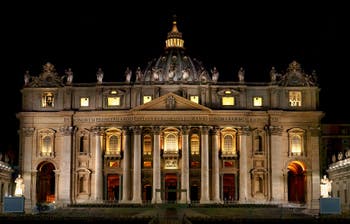
Saint Peter's Basilica It took 1,300 years to complete the construction of St. Peter's Basilica as we know it today.
St. Peter of the Vatican is the largest Christian basilica in the world, due to its impressive dimensions: 218.7 metres long (portico included) and a 154.8 metres transept for an area of 22,067 m2!
The facade of St. Peter's Basilica in Rome is 114.7 metres wide and 47.3 metres high, a facade supported by eight large 28 metres high Corinthian columns.
The famous and superb dome of St. Peter's Basilica was designed and built by Michelangelo.
With a diameter of 42.56 metres, its height from the ground to the top of the cross that overcomes it reaches 136.57 metres!
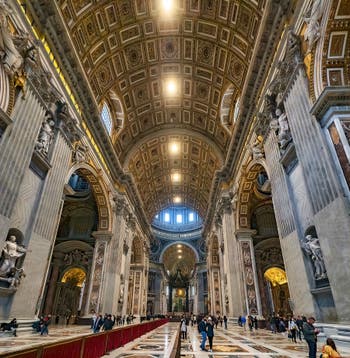
Saint Peter's Basilica The portico of St. Peter's Basilica of the Vatican is no less remarkable: 71 metres wide, 138 metres with the vestibules, all under 18 metres of ceiling height.
As for the interior of St. Peter, everything is in the endorsement: 46 altars, 748 columns and 386 statues.
Placed exactly under Michelangelo's dome, here is the magnificent canopy where the Pope's office with four monumental bronze columns totalling 10 tons, an impressive work by Gian Lorenzo Bernini.
Believing or not, a feeling of power, majesty and beauty seizes you as soon as you cross the threshold of this architectural and religious jewel.
We enter a prestigious place, unique in the world, at the heart of the spirituality that marked the history of our civilization, an unforgettable experience.
Saint Peter of the Vatican in Rome: the heart of Christendom
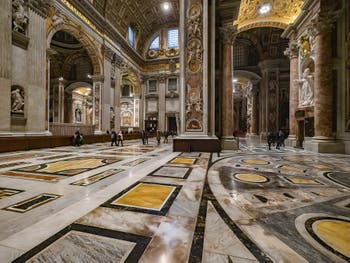
Saint Peter's Basilica St. Peter's Basilica in Rome symbolizes the living heart of Christendom while representing its power.
According to legend, but perhaps as truly, it was built at the exact location of the burial of St. Peter.
The Colosseum and St. Peter's Basilica are the two most famous and impressive monuments in Rome.
But it is the basilica that regularly makes headline televisions around the world, on the balcony of which appears every new pope, facing which the crowd gather to listen to his homilies.
In Rome, St. Peter's Basilica is a must, as well as the Vatican Museum; coming to Rome without visiting them would be as if you were missing the Louvre and the Eiffel Tower in Paris.
Saint Peter's Basilica in Rome in Italy: 43 Popes
Forty-three Popes succeeded each other from 1450 to 1626 to complete St. Peter of the Vatican.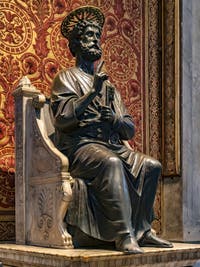
Saint Peter's Basilica Before becoming this extraordinary place of art and worship, the history of the construction of the basilica was very complex: for the period of its construction from 1450 to 1626, no less than 43 successive popes will have decided on its final appearance.
However, we need to go back more than a thousand years ago to understand the religious importance of St. Peter of the Vatican.
In the year 320, the Roman emperor Constantine decided to have this basilica built on the very site of the tomb of St. Peter's apostle.
Saint Peter was indeed martyred in the circus of Nero which was right next to the current location of St. Peter's Basilica of the Vatican.
This Basilica of Constantine was consecrated by Pope Silvestre I in 326 and completed in 349.
This first St. Peter's Basilica was already very large, it included five naves and a large atrium.
Unfortunately a little more than a thousand years later, she was in such a state of disrepair that she threatened to collapse on the faithful.
Saint Peter: A succession of architects and different projects
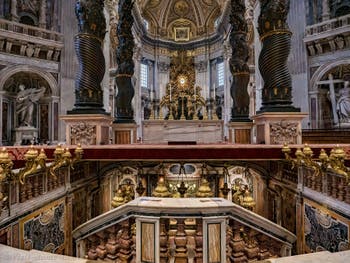
Saint Peter's Basilica Faced with the risk of the collapse of the basilica of Constantine and its consequences not only in terms of risk but also of a negative image for Christendom, Pope Nicholas V decided in 1450 to rebuild it and even enlarge it.
He commissioned the architects Bernardo Rossellino and Leon Battista Alberti to do this.
But when they died, there were hardly a few beginnings of walls flush on the site.
It was not until half a century before in 1506, Pope Julius II de la Rovere resumed construction on the basis of new plans drawn up by the architect Bramante.
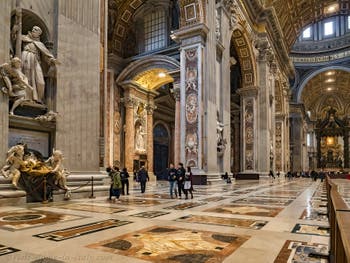
Saint Peter's Basilica Shortly before Bramante's death, the first four pillars of the new basilica and their arches were in place.
The new Pope Leo X de Medici asked the architect Giuliano da Sangallo the young to resume the work.
But Sangallo died in 1517, and the project was entrusted to Raphael.
Who Raphael died in turn in 1520, he gave way to the architect Giocondo da Verona, who then succeeded Baldassare Peruzzi.
As can be imagined, this succession of talented architects all with a personal idea and not always in accordance with that of their predecessor could hardly advance the construction site of the basilica.
The projects were indeed different, if not totally contrary to their predecessors.
Saint Peter's Basilica: Michelangelo and the Dome
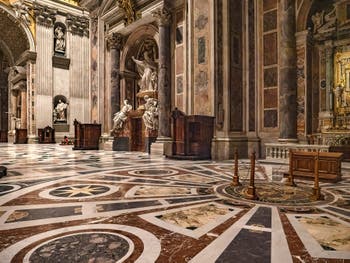
Saint Peter's Basilica
A plan to Greek Cross or Latin Cross?
The Basilica of Bramante had a Greek cross plan, modified by Raphael who wanted a Latin cross basilica, contradicted by Peruzzi who had returned to the original Greek cross plan of Bramante.But the choice of the Greek or Latin cross plan was then added that of financing reconstruction.
At the death of Pope Leo X de Medici in 1521, the Church's finances were at the lowest and its successors were forced, for lack of resources, to abandon the project.
Michelangelo new architect of St. Peter's Basilica
In 1547 the work resumed at the initiative of Pope Paul III Farnese, who chose to assign himself the services of Michelangelo, who was already 72 years old, as a new architect.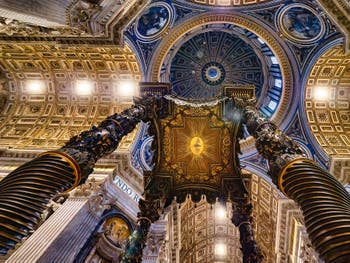
Saint Peter's Basilica Michelangelo decided to resume the idea of a basilica with a Greek cross plan, while enlarging the rostrum and the cross.
Michelangelo also decided to build a dome different from that planned by Bramante, drawing inspiration from that of the Florence Duomo built by Brunelleschi.
A 16-sided dome, inside and outside to make it even more solid.
For 17 years Michelangelo dedicated himself to this colossal undertaking until his death in 1563, at the age of 89.
Unfortunately, he could not contemplate his finished work, only the drum of the dome was completed at the time of his death.
The architects Piero Ligorio and Jacopo Barrozzi da Vignola were then instructed to continue the work by scrupulously following Michelangelo's plans.
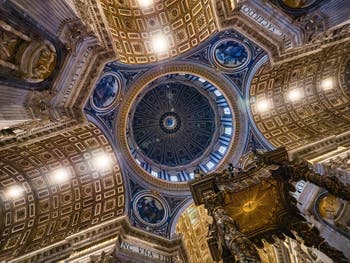
Saint Peter's Basilica They also disappeared before they could admire the completion of the basilica.
They were followed by Domenico Fontana, but it was his successor, Giacomo della Porta, the new architect appointed by Pope Gregory XIII who was the first to contemplate the completed dome.
Della Porta had resumed work on July 15, 1588, and finally completed it 22 months later, under the new pontificate of Sixtus V.
Pope Sixtus V, who wanted to see this project complete, had put the means: 200,000 ducats of gold and 800 workers working day and night!
Shortly after Sixtus V's death, the dome was covered with lead plates, then crowned with its lantern topped by its large ball with its cross at its top in 1593.
It was under the pontificate of Clement VIII that Giacomo della Porta continued his work until his death in 1601.
Michelangelo's project was then carried out in its entirety, with the exception of the facade and the portico.
Saint Peter's Basilica of the Vatican in Rome: Facade and Latin Cross
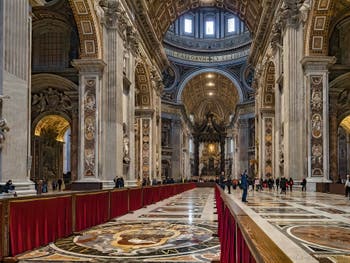
Saint Peter's Basilica
Carlo Maderno: Facade, Portico and return of the Latin Cross
In 1606 Pope Paul V asked architect Carlo Maderno to create the portico and the facade.An architect who, in agreement with the pope, abandoned Michelangelo's project and decided to return to Raphael's draught Latin cross plan, increasing the length of the central nave of the basilica by 80 metres.
He then built the current facade.
An architectural choice which, by projecting 80 metres forward the façade of the basilica, resulted in hiding the base of Michelangelo's dome.
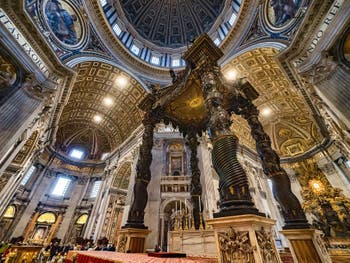
Saint Peter's Basilica As a result, the entire dome can only be seen from some windows of the Vatican Museum or moving away from the basilica or, better yet, from the terrace of Castel Sant'Angelo.
A superb terrace that also offers one of the most beautiful 360° views of Rome.
The works of the central nave were completed in 1612 and the façade and porch in 1614.
By his genius, Bernini succeeded in amplifying the impression of grandeur and beauty of St. Peter's Basilica of the Vatican.
The same Bernini also made the superb bronze canopy located under the dome, a colossal work initiated in 1624 and completed in 1633 under Urban VIII.
Art Story Architecture | Michelangelo Pietà
St.Peter Art Story | Location | Opening Hours Tickets | Authorisations
Churches St.Peter | Pantheon |
Back to Top of Page

